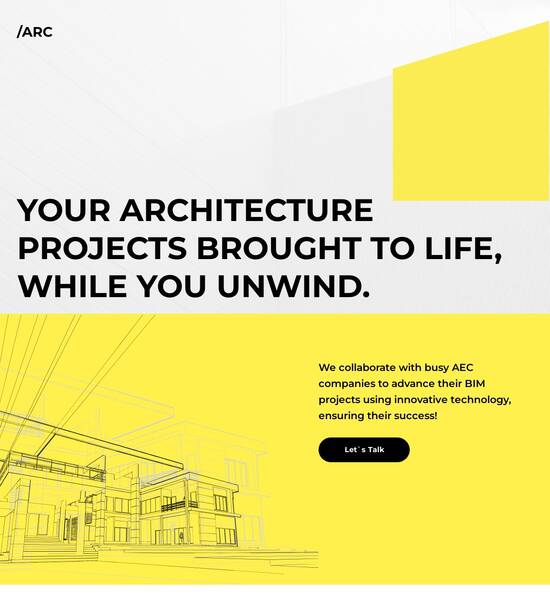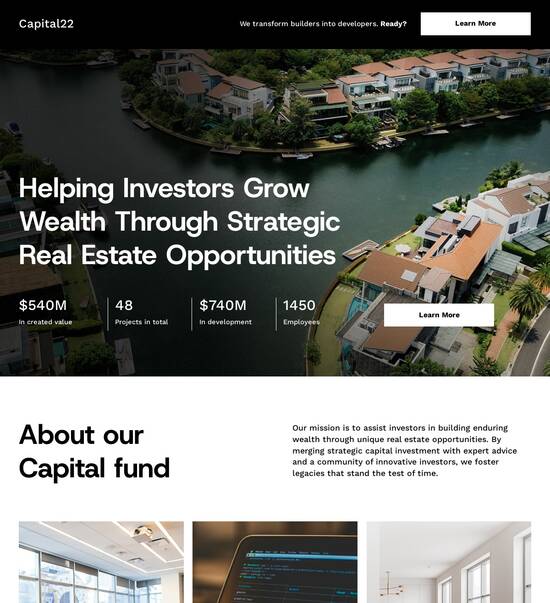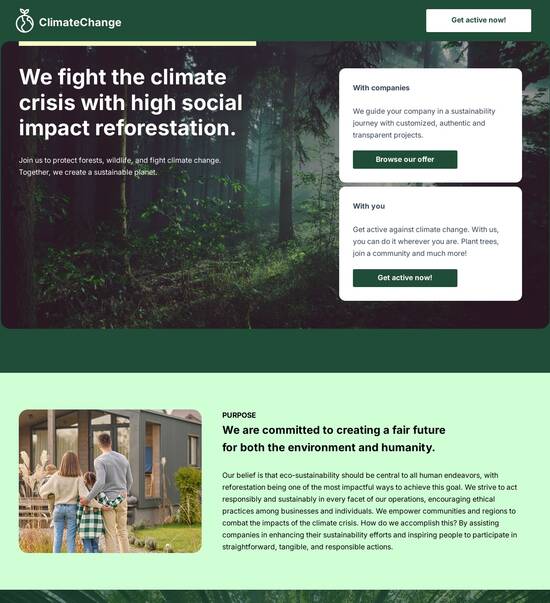
HTML page template with interactive student enrollment form
Explore Similar TemplatesAbout template
Use HTML page templates with interactive student enrollment form and make your communications easy and transparent. Try our solution today.
Recommended templates

Easy to build without coding
With the intuitive drag-and-drop builder, anyone on your team can create high-converting pages without any knowledge of code or design. Make enhancements to your landing page with custom widgets using Javascript, HTML/CSS, or third-party scripts.

Multiple layouts for any industry and goal
Select from 500+ landing page layouts built to boost conversions across industry-specific scenarios. Customize them by adjusting fonts, adding images, and generating on-brand content with the AI assistant. Quickly scale with Instablocks® and Global Blocks that you can save, reuse, and update globally.

Loads fast and looks polished on any device
Every template is responsive, which means they present professionally on any device and load blazingly fast with our Thor Render Engine. You can also power them up with Google AMP technology to deliver an unparalleled mobile experience and drive higher conversions.

Robust analytics & experimentation
Get real-time updates and reporting across all your devices, showing the number of visitors, conversions, cost-per-visitor, and cost-per-lead. Launch AI-powered experiments, run A/B tests, and use heatmaps to analyze user behavior, then optimize your landing page to maximize conversions.







Easy to build without coding
With the intuitive drag-and-drop builder, anyone on your team can create high-converting pages without any knowledge of code or design. Make enhancements to your landing page with custom widgets using Javascript, HTML/CSS, or third-party scripts.
Multiple layouts for any industry and goal
Select from 500+ landing page layouts built to boost conversions across industry-specific scenarios. Customize them by adjusting fonts, adding images, and generating on-brand content with the AI assistant. Quickly scale with Instablocks® and Global Blocks that you can save, reuse, and update globally.
Loads fast and looks polished on any device
Every template is responsive, which means they present professionally on any device and load blazingly fast with our Thor Render Engine.
Robust analytics & experimentation
Get real-time updates and reporting across all your devices, showing the number of visitors, conversions, cost-per-visitor, and cost-per-lead. Launch AI-powered experiments, run A/B tests, and use heatmaps to analyze user behavior, then optimize your landing page to maximize conversions.
All the features you need to build student registration form html template
Explore more featuresLearn how to build free enrollment form template
Frequently asked questions about school registration form html
Leading the way in building high-performing landing pages





Html code for student application form: Your ultimate how-to guide
In a competitive landscape where every click counts, using Instapage's landing page templates can significantly enhance your digital marketing strategy. This guide outlines the essential steps to leverage these powerful tools effectively, catering specifically to marketers in various sectors such as education, financial services, and technology.
Understanding the importance of landing pages
Landing pages are designed specifically to convert visitors into leads or customers. They eliminate distractions, providing potential customers precisely what they seek. It's crucial to understand that a well-optimized landing page can lead to substantially improved ROI for your campaigns.
- Enhanced focus on conversion goals: Each landing page layout promotes specific actions, from signing up to making a purchase.
- Low barriers to entry: Simple yet effective forms help capture leads without overwhelming potential customers.
- Data-driven decisions: Instapage provides analytics that help refine strategies based on user behavior.
Step 1: Choose your template wisely
Selecting the right template is integral to your campaign's success. Instapage offers over 100 customizable options suited to various industries. Focus on templates designed for your target audience, ensuring they resonate with your marketing message.
Step 2: Optimize your landing pages
Optimization goes beyond aesthetics; it's about performance. Leverage Instapage's built-in A/B testing and detailed analytics to gauge what works best.
- Create A/B tests for different layouts: Discover which designs lead to more conversions and iterate accordingly.
- Use heatmaps for visual insights: Understand where users are clicking, helping you to adjust content placement effectively.
- Implement SEO best practices: Ensure your landing pages are optimized for search engines to attract organic traffic.
Step 3: Personalize the user experience
Tailoring your content to meet the unique needs of various audience segments is essential. Utilizing features like dynamic text replacement, you can adjust pages to reflect the interests and characteristics of your visitors.
- Align ads with specific landing pages: Ensure that users see messages that match their previous interactions.
- Utilize audience-level tracking: Analyzing data per audience segment allows for more targeted marketing efforts.
- Craft compelling calls-to-action: Tailored CTAs enhance engagement based on audience behavior.
By following these steps, you can fully utilize Instapage’s features to create compelling and high-converting landing pages.
Ready to get started? Explore Instapage's library of landing page templates and experience a seamless marketing journey that maximizes your campaign results.
People also ask about student registration form template html css free download
Unveiling an interactive HTML page template: student enrollment form
Understanding interactive HTML page templates
HTML templates are pre-structured web pages designed to streamline the web development process. These templates offer a framework where developers and designers can customize elements without starting from scratch. This feature significantly reduces the time spent on coding repetitive elements. With an emphasis on user interaction, leveraging interactive forms can transform static web pages into engaging experiences that encourage user input and participation.
In the context of student enrollment, interactive HTML templates serve a crucial role. They not only present essential information but also facilitate an intuitive registration process. A well-designed interactive enrollment form enhances user experience, simplifying the pathway for prospective students to submit their applications. By focusing on the user's journey through engaging, interactive elements, institutions can significantly increase conversion rates, turning casual visitors into actual enrollees.
Core features of the student enrollment form template
Customizable layout and design options are paramount when developing a student enrollment form template. Institutions can choose from various layout positions to best fit their branding and messaging approach. The arrangement of fields, including the placement of names, contact details, and course specifics, directly affects user engagement. Ensuring that fields are positioned in a logical sequence not only facilitates ease of use but also enhances the likelihood of form completion.
A user-friendly editor is essential for anyone looking to personalize their enrollment form quickly. This editor should allow users to modify aesthetics seamlessly, such as changing colors, fonts, and field placements. By following these steps: first, users can select a predefined template; next, they can use the drag-and-drop feature to rearrange form elements; finally, tweaking individual styles can further align the form with institutional branding. This level of customization ensures a unique user experience that aligns with institutional standards.
Flexible layouts allow for adjustments as per institutional needs.
Editors simplify the modification of designs for end-users.
Possibility for integration with other services to enhance functionality.
Responsive design principles are critical for any modern webpage, and student enrollment forms are no exception. Since students may access the form from various devices, including smartphones and tablets, ensuring a mobile-friendly experience is essential. This design approach ensures that all users, regardless of their device, can easily navigate and complete the enrollment form.
Engaging user experience: captions and informative sections
Effective use of captions and labels plays a significant role in guiding prospective students through the registration process. Well-crafted captions help outline what information is being requested, increasing clarity and reducing frustration. For example, labeling a field as 'Preferred Course' rather than just 'Course' gives students context. It’s essential to implement best practices for field labeling, such as keeping language simple and relatable, thus minimizing user confusion.
Incorporating informative tooltips can also provide additional guidance without cluttering the enrollment form. These tooltip popups can offer context-sensitive help, explaining field requirements or giving examples of acceptable information. For instance, hovering over a date field can show the required format or explain why specific date ranges are necessary. This interaction not only aids in user understanding but fosters a sense of support throughout the registration journey.
Enhancing functionality with plugins
Integrating advanced functionalities can significantly enhance the student enrollment form. For example, payment gateway plugins enable institutions to collect course fees directly from the registration form. This integration simplifies the process both for the student and the institution, thereby improving conversion rates. Additionally, calendar tools can help students schedule classes or meetings with academic advisors, which is particularly crucial for freshen up students who may need guidance on course selection.
Optimizing feedback mechanisms is another way to enhance the functionality of the enrollment form. Implementing real-time validation ensures that users receive instant feedback as they fill out the form. For instance, if a student enters an invalid email address, a notification could inform them to correct it before proceeding. Using animations or notifications upon completing each step of the form keeps users engaged and reinforces a sense of progress, ultimately leading to higher completion rates.
Crafting an effective enrollment process: order and flow
Streamlining the registration process largely hinges on how questions are structured. A logical flow of inquiries guides users naturally from one point to the next, reducing cognitive overload. Start with easy, non-threatening questions before moving on to more complex ones. In addition, breaking the form into manageable sections or pages can help mitigate user fatigue. This tactic enables users to focus on one section at a time, promoting higher completion rates.
It’s also important to prioritize essential information during the registration process. Identifying which data points are crucial for enrollment helps to minimize unnecessary queries that could overwhelm users. Incorporating dropdown menus and pre-filled options can simplify this process, as they quickly guide students to select the required information without extensive typing. Streamlining this aspect reflects an understanding of user needs, thus enhancing their overall experience.
Analyzing consumer behavior
Understanding customer patterns through data analysis can dramatically improve form design and functionality. By analyzing how users interact with the enrollment form—such as where they spend the most time or where they drop off—institutions can identify pain points and areas for improvement. Implementing analytics tools not only allows for tracking completion rates but also helps uncover abandonment points that require attention, guiding iterative design changes.
Segmenting user demographics is another strategic approach to enhance enrollment forms. By tailoring the form to fit different user groups, including undergraduate, graduate, or international students, institutions can effectively engage specific audiences. Customization features enable educational institutions to adjust content and question types to respond better to the needs and expectations of varying demographics, leading to heightened engagement and completion rates.
Best practices for layout and aesthetics
Design considerations hold significant weight in how users interact with enrollment forms. Psychological factors such as color schemes and typography can influence user emotions and engagement. Employing inviting colors and easy-to-read fonts creates a welcoming atmosphere, enhancing user trust. Consistency in visual design across all elements of the enrollment form fosters familiarity, making it easier for users to navigate smoothly.
Placement of key actions, such as call-to-action buttons, is crucial for maximizing impact. Strategic ordering of buttons ensures that users are guided logically through the process. For example, placing the 'Submit' button within a user's line of sight upon completing the form assists in encouraging completion. It’s also vital to create visual distinctions between different types of actions—such as submitting information and changing preferences—to help users easily understand their options.
Future innovations in student enrollment forms
Trends in interactive design continue evolving, with specific reference to technological advancements like AI and machine learning. These innovations have the potential to transform student engagement with forms by offering personalized experiences based on previous interactions. Institutions can utilize automated responses that guide students through choices in real-time, ensuring a tailored experience that addresses individual needs.
Integrating feedback mechanisms for continuous improvement is also key in this context. Conducting user surveys after enrollment can uncover valuable insights about their experiences. Utilizing this feedback in an iterative design process allows institutions to refine their enrollment forms further and adapt to user needs over time. This responsiveness positions educational institutions to stay ahead, cultivating stronger connections with prospective students.
Conclusion: the new wave of student enrollment
As institutions adopt interactive HTML page templates for student enrollment forms, the transformation of user experience becomes evident. These forms, with their engaging interfaces and streamlined processes, significantly enhance how prospective students experience registration. Emphasizing user-friendly designs not only drives higher conversion rates but also fosters greater satisfaction among users. In this evolving landscape, structured templates represent the future of student enrollment, paving the way for widespread adoption and improved experiences across educational institutions.
Ready to skyrocket conversions?
Supercharge your ad campaigns with high-performing landing pages
Get started














